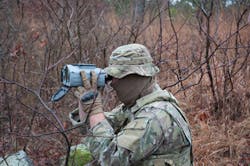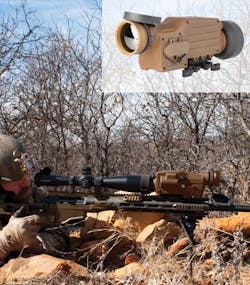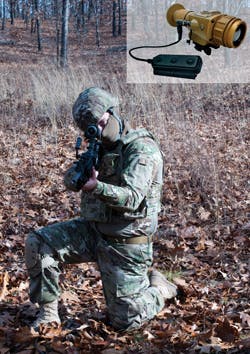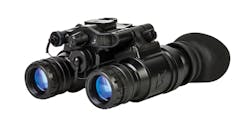The evolution of night-vision devices
Enhancements in size, weight, power consumption, and cost are bringing night-vision capability to nearly every warfighter on the front lines, with police, automotive, and commercial uses not far behind.
Since the first Persian Gulf War in 1991, and even before, one of the U.S. military's most important goals has been to own the night with a broad range of night-vision devices that rely on technologies like infrared (IR) imaging and light intensification.
The early night-vision devices that enabled U.S. and allied forces to prevail in that first Gulf War more than a quarter-century ago were relatively heavy and bulky, and required substantial power sources to run them. Today it's different, and advances in the size, weight, power consumption, and cost (SWaP-C) of military night-vision devices are putting these sensors into the hands of a growing number of warfighters, and are helping to proliferate night-vision sensor technology into public safety applications, and hold promise for commercial, automotive, and medical applications in the near future.
"The key is the detector," says Adam DeAngelis, director of marketing for surveillance equipment at FLIR Systems in Wilsonville, Ore. "In the future these devices will be lighter in weight, and will save more power." At FLIR, researchers are making progress in reducing the pitch size of the sensor, which refers to the size of the individual detectors in the sensor array, DeAngelis explains.
FLIR Systems specializes in long-wave infrared sensors for thermal imaging, which detects light in wavelengths of 8 to 15 microns-outside the human eye's ability to perceive light. This kind of sensor typically detects the heat signature of objects against a cooler background.
"Size, weight, and power are at the forefront of everything we do here," says Darrell Hackler, senior director of global business development for the Harris Corp. Night Vision segment in Roanoke, Va. Harris Night Vision (formerly ITT and Exiles Night Vision) specializes in light-intensification technology for military night-vision goggles, night-vision monoculars, and night-vision weapon sights.
"If you go back in time and look at what night-vision devices started out to be and what they are today, it is a natural progression for things to be smaller, lighter, and offer a higher-performing product," Hackler says.
Pitch and pixels
Perhaps the most important aspect of bringing down the size of today's night-vision devices is the size of the pixel in the sensor's detector array. "The volume of an imaging system is defined by how small and fine your pixel is," explains Tony Bacarella, vice president of dismounted systems at the Leonardo DRS Inc. Electro-Optical and Infrared Systems segment in Dallas.
"In the long-range uncooled IR detector area, most of our competition is going from a 17- to a 12-micron pixel," Bacarella says. "DRS has gone down to a 10-micron pixel. That is a 40-percent reduction in the image plane. The main thing is it drives the system's size and weight smaller; it all drives size and weight."
As the sizes of night-vision sensors have come down, these new technologies lend themselves to a growing number of applications. "The smaller the pixel, the more platforms you open yourself up to," Bacarella says. "With enhanced SWaP-C you will see these sensors on more UAVs [unmanned aerial vehicles] and other platforms that will be hugely significant."
Additional systems-integration benefits emerge as sensor sizes goes down, points out FLIR's DeAngelis. "As the array size comes down, there is less cooling power and battery power you need to use, and that has a trickle-down benefit through the entire product.
"As the detector sizes come down, you save more power, but you gain in range because you can put a larger lens on and see farther," DeAngelis continues. "Everything depends on the size of the array and on the quality of the imaging power."
Shrinking the size of the pixels in night-vision sensor arrays can offer a design trade-off that involves resolution vs. sensor size. Certainly a larger number of small pixels could offer high resolution, but systems designers often choose to reduce the size of the array as a way to reduce overall system size.
Evolution of pixel size
Back during the first Gulf War and before, uncooled long-wave infrared sensor pixel size was 50 microns, and after that it evolved to 25 and then to 17 microns, says DRS's Bacarella. "It was a big jump from 50 to 25 microns. Then you're talking about a system at 17 microns that is half as long and 50 percent lighter than what you used to have.
"From 17 microns to 10 microns, the shift in the size of the optic becomes so big, and you have other benefits from improvements in FPGAs [field-programmable gate arrays], displays, and other processing assets," Bacarella continues. "At this stage the power requirements are such that you can start eliminating batteries from the system."
The density of long-wave infrared sensor arrays has doubled in just a short amount of time. "We had 320-by-240-pixel arrays a few years ago, and now 640 by 512 is the standard," says FLIR's DeAngelis.
Reduced pixel size in the detector, however, has its drawbacks, DeAngelis cautions. "You can make a pretty small array, but the actual noise level you will get out of it, and your gain, might not be something you would put into the hands of the military or law enforcement," DeAngelis says.
The amount of noise in a night-vision image is a product of how well the sensor is manufactured, and how designers use sensor-processing technologies. Enhancements in these areas can help, but likely never will never eliminate noise altogether. "There always will be noise in an image, DeAngelis says. "There always will be other photons in there that you don't want. It's very important how you process it to show the best image."
With such a quick pace of evolution in the size, weight, power consumption, and cost of night-vision sensors, what might be in store for the near future? Industry experts say the rate of improvements is likely to slow.
"There is a lot of discussion about reducing the size of the pixels, but that is not likely to change in the next five years," says DRS's Bacarella. "When you think about the pixel, long-wave is 8 to 12 microns. We're at a 10-micron pixel pitch now I don't think it will go down to 5 microns; you would lose your bang for the buck at that point."
System-level designs
Instead, the industry crusade to reduce system size likely will focus on optics and other areas. "A bigger gain at the system level might be reducing the optics between 10 and 30 percent," Bacarella says.
"Germanium typically is used to see in the long-wave band. It is very expensive, and the more you can reduce that, the better off you are."
At Harris Night Vision, engineers are trying to reduce the size of the company's image-intensification tube, but are looking to other system-level factors as well. "The magic behind seeing at night is the image-intensification tube," says Harris's Hackler. "That's where we change photons into the electrons, and it is a standard size. There's a certain amount of space that it takes to do that."
For the company's night-vision goggles, helmet-mounted night-vision devices, and weapon sights, Harris designers are looking at mounting configurations and other areas where they could shave size and weight. "Once you have the magic piece reduced in size, then the rest is just packaging," Hackler says.
Key issues that Harris designers deal with, Hackler says, involve how heavy and balanced the device is to the user. "Is it too heavy; does it have too much forward projection, or too much weight on the helmet that changes the user's center of gravity?" Harris also is in talks with military helmet manufacturers to integrate night-vision devices directly into the helmets of warfighters of the future, Hackler says.
New capabilities
Wired and wireless networking is providing new options for night-vision device users. The DRS ENVG III night-vision device, for example, offers off-boresight capability that enables the warfighter to link his weapon sight to his night-vision goggles. This can speed target acquisition, enable the warfighter to shoot from the hip, as well as around corners or over obstacles.
The system transmits the image from the warfighter's weapon sight through a wireless connection to a battery pack attached to the back of the soldier's helmet, which then transmits the weapon sight's image to the night-vision device's eyepiece through fiber optic cables. This capability could be available to deployed warfighters in the next few years.
Networking night-vision devices comes naturally to Harris Night Vision, which is a sister company to Harris RF Communications in Rochester, N.Y.-one of the world's most advanced military radio communications systems designers. "Harris traditionally is a communications company, so we can network the goggle to the radio," says Harris's Hackler.
Connecting digital communications systems like a software-defined radio to night-vision goggles offers the potential of transforming the soldier's goggles into a heads-up device that can display real-time text messaging, intelligence imagery, and enable the warfighter on the front lines to act as a sensor node on tactical military networks.
"Certain text messages and other information for situational awareness can be transmitted to the soldier through his goggle," Hackler says. "He can capture and send back video to the tactical information center from the goggle. It was a natural fit for us to integrate the night-vision goggle to the communications network."
In the future, infantry warfighters also might be able to overlay intelligence imagery over what they see through their night-vision goggles in a type of augmented reality that could speed tactical engagements and help reduce incidents of friendly fire casualties.
Blending tactical networking with night-vision devices also offers new capabilities for intelligence gathering and dissemination. "I think technology will split off into two sides: traditional optical imaging like a soldier's weapon sight, and an analytical portion where IR is the sensor," says FLIR's DeAngelis.
This design approach could offer the ability to use imagery and video captured and recorded from a warfighter's night-vision device for extensive intelligence analysis at a combat command post or at higher echelons.
A warfighter wearing night-vision goggles while operating on the front lines, for example, is concerned primarily with threats and opportunities right in front of him, and might miss something in the background that could be significant to an intelligence analyst. The infrared signature of recently disturbed dirt, for example, might escape the warfighter's notice, but actually might indicate the presence of an improvised explosive device (IED).
Night vision for everyone
As costs come down and performance increases, it stands to reason that night-vision devices will come into the hands of an increasing number of people-including many who might never consider a need for night-vision capability.
FLIR Systems, for example, offers the FLIR ONE thermal imaging camera attachment for Apple and Android smart phones, which is available commercially for as little as $200. This affordable capability can enable those leaving work late to scan a dark parking lot for lurking muggers, look into a dark backyard at night to determine if that thump was from a burglar or a raccoon, or aid in navigating a house when the power goes out.
Such affordable night-vision capability also has the potential to notify homeowners of pipe leaks, electrical wiring malfunctions, or heat leaks in an attic's insulation. It's clear that night-vision technology in the future could be as common as GPS is today.
"We want to bring thermal imaging to everyone at a price low enough so that everyone has access to it," says FLIR Systems's DeAngelis. "I think that will happen, but it will be a tool that you don't even know you're using."




